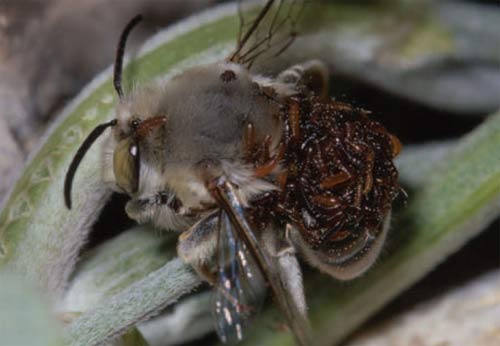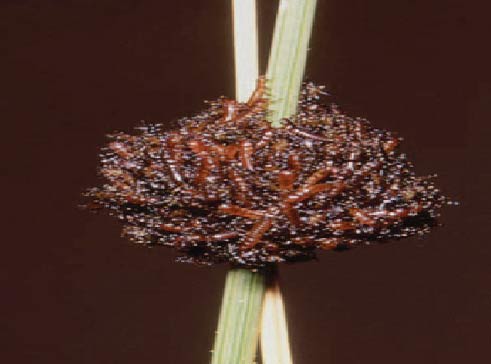The beetle of the beetle
The beetle's larvae form the bees that are so ingenious that male bees will try to pair with them and bring them home. These larvae thus live in luxury by the food and shelter of the owner.
Scientists believe that this behavior is the first example of collaborative and aggressive tampering known in insects. Collaborate in that the larvae overlap and act consistently as if they were just a single female bee. This behavior is considered aggressive because once it gets into the honeycomb, the stealthy parasite will eat clean bee eggs or food that the landlord has been searching hard for.
Leslie Saul-Gershenz, conservation director at the Ecological Survival Center in San Francisco and colleagues, studied these insects in the Mojave National Reserve, California, USA. They found that the mock ban's phony action occurred in four steps.

Bees unknowingly carry the beetle's larvae back to their nests.(Photo: Discovery)
First, the worm larvae hatch from the eggs in the leaf bases, then they pile into a sphere before crawling up the stem.
These insects then release their secret weapon - a chemical similar to the female bee's sex hormone - and wait. Thanks to the release of " perfume ", the beetles will touch any male bees nearby.
"The larvae widen the upper body and the forelimbs, which carry specialized claws to adapt to clinging."
The baby bugs then cling to the male bee's back. When male bees mate with a true female bee, it will inadvertently transfer these "larval goods" to females. The larvae ride on the bee's back and fly to the hive, where they will grow and mature, and the cycle will begin.
Scientists believe that this scam is a survival tool for bananas - the creatures must live in the harsh conditions of the Mojave desert, where temperatures are often above 37 degrees C.

Beetle larvae (Photo: Discovery)
T. An
- The assassin unleashes the beetle at mating
- A beetle named after the young environmental activist Greta
- Not an alien, this is the most exotic giant bug on Earth
- 6-leg beetle
- Giant beetle 'compared to' emperor scorpions: Which species deserves the title?
- Exotic species that eat the bug beetle poison to clean up
- 'Unveiled' beetle's secret
- Hello! I am a stalker and these are aspects you have never known about me!
- Find out how to make a living insect into a hybrid beetle between living organisms and machinery
- Application of spray technology from Bombardier Beetle beetles
- The beetle has a heart-shaped leg burning
- How is the beetle 'love' underwater?
 Why do potatoes have eyes?
Why do potatoes have eyes? 'Tragedy' the world's largest carnivorous life: Death becomes ... public toilet
'Tragedy' the world's largest carnivorous life: Death becomes ... public toilet Tomatoes were once considered 'poisonous' for 200 years
Tomatoes were once considered 'poisonous' for 200 years Detecting microscopic parasites on human face
Detecting microscopic parasites on human face Detecting insects helps people collect plastic waste
Detecting insects helps people collect plastic waste  Students raise strange flies to make them 'eat' garbage
Students raise strange flies to make them 'eat' garbage  The only fly factory in the world
The only fly factory in the world  Score 4 'monsters' in your body
Score 4 'monsters' in your body  Detecting strange creatures whose heads do not have bodies
Detecting strange creatures whose heads do not have bodies  What is 'monster larva' actually?
What is 'monster larva' actually? 